Critical Appraisal of Research Papers on Pediatric Healthcare Issues
VerifiedAdded on 2023/04/21
|15
|4206
|192
Case Study
AI Summary
This assignment presents a critical appraisal of two research papers focusing on pediatric healthcare. The first paper examines the effectiveness of a warm lidocaine/tetracaine patch versus placebo for pain management during intravenous cannulation in pediatric patients, assessing the study's hypo...

Running head: CRITICAL APPRAISAL
CRITICAL APPRAISAL
Name of the Student
Name of the university
Author’s note
CRITICAL APPRAISAL
Name of the Student
Name of the university
Author’s note
Secure Best Marks with AI Grader
Need help grading? Try our AI Grader for instant feedback on your assignments.
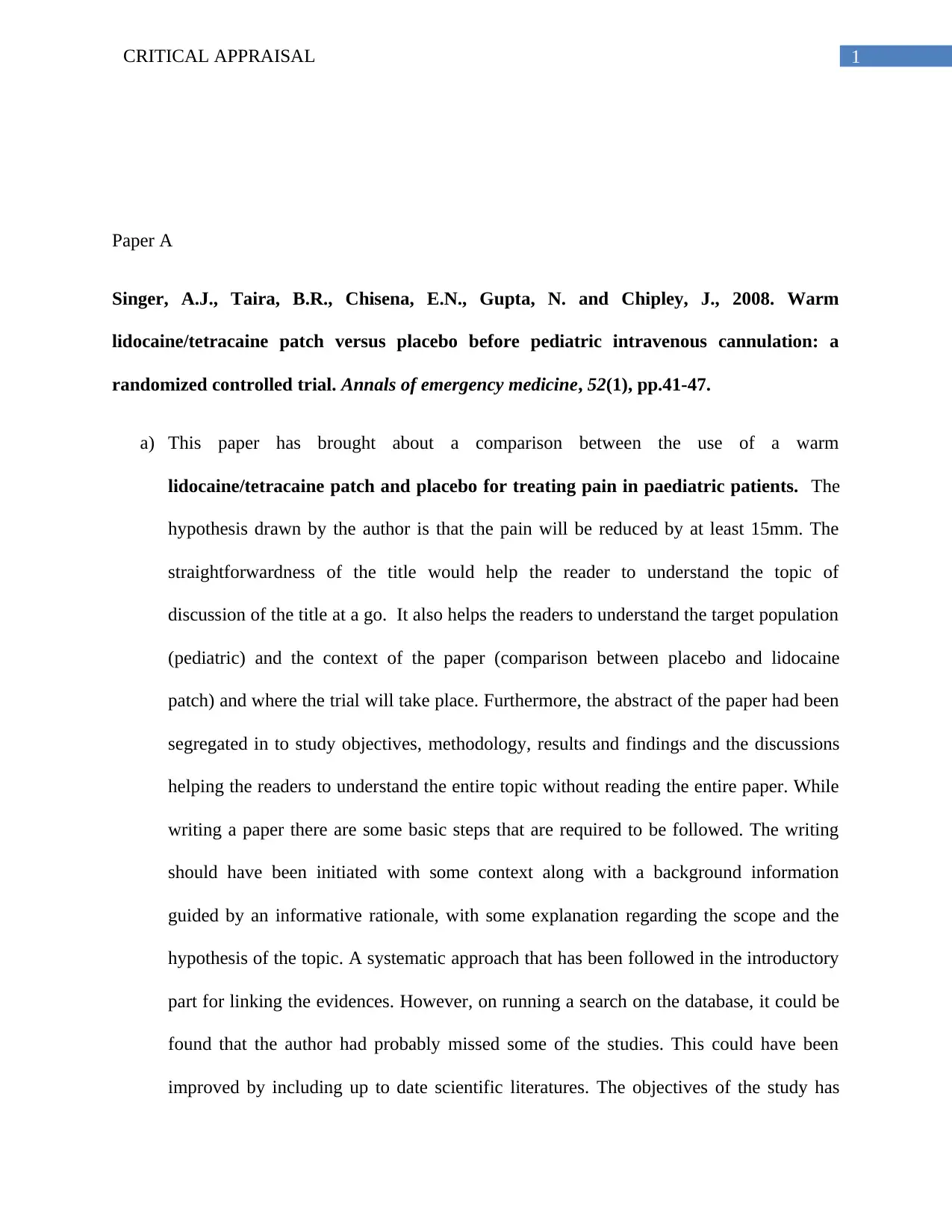
1CRITICAL APPRAISAL
Paper A
Singer, A.J., Taira, B.R., Chisena, E.N., Gupta, N. and Chipley, J., 2008. Warm
lidocaine/tetracaine patch versus placebo before pediatric intravenous cannulation: a
randomized controlled trial. Annals of emergency medicine, 52(1), pp.41-47.
a) This paper has brought about a comparison between the use of a warm
lidocaine/tetracaine patch and placebo for treating pain in paediatric patients. The
hypothesis drawn by the author is that the pain will be reduced by at least 15mm. The
straightforwardness of the title would help the reader to understand the topic of
discussion of the title at a go. It also helps the readers to understand the target population
(pediatric) and the context of the paper (comparison between placebo and lidocaine
patch) and where the trial will take place. Furthermore, the abstract of the paper had been
segregated in to study objectives, methodology, results and findings and the discussions
helping the readers to understand the entire topic without reading the entire paper. While
writing a paper there are some basic steps that are required to be followed. The writing
should have been initiated with some context along with a background information
guided by an informative rationale, with some explanation regarding the scope and the
hypothesis of the topic. A systematic approach that has been followed in the introductory
part for linking the evidences. However, on running a search on the database, it could be
found that the author had probably missed some of the studies. This could have been
improved by including up to date scientific literatures. The objectives of the study has
Paper A
Singer, A.J., Taira, B.R., Chisena, E.N., Gupta, N. and Chipley, J., 2008. Warm
lidocaine/tetracaine patch versus placebo before pediatric intravenous cannulation: a
randomized controlled trial. Annals of emergency medicine, 52(1), pp.41-47.
a) This paper has brought about a comparison between the use of a warm
lidocaine/tetracaine patch and placebo for treating pain in paediatric patients. The
hypothesis drawn by the author is that the pain will be reduced by at least 15mm. The
straightforwardness of the title would help the reader to understand the topic of
discussion of the title at a go. It also helps the readers to understand the target population
(pediatric) and the context of the paper (comparison between placebo and lidocaine
patch) and where the trial will take place. Furthermore, the abstract of the paper had been
segregated in to study objectives, methodology, results and findings and the discussions
helping the readers to understand the entire topic without reading the entire paper. While
writing a paper there are some basic steps that are required to be followed. The writing
should have been initiated with some context along with a background information
guided by an informative rationale, with some explanation regarding the scope and the
hypothesis of the topic. A systematic approach that has been followed in the introductory
part for linking the evidences. However, on running a search on the database, it could be
found that the author had probably missed some of the studies. This could have been
improved by including up to date scientific literatures. The objectives of the study has
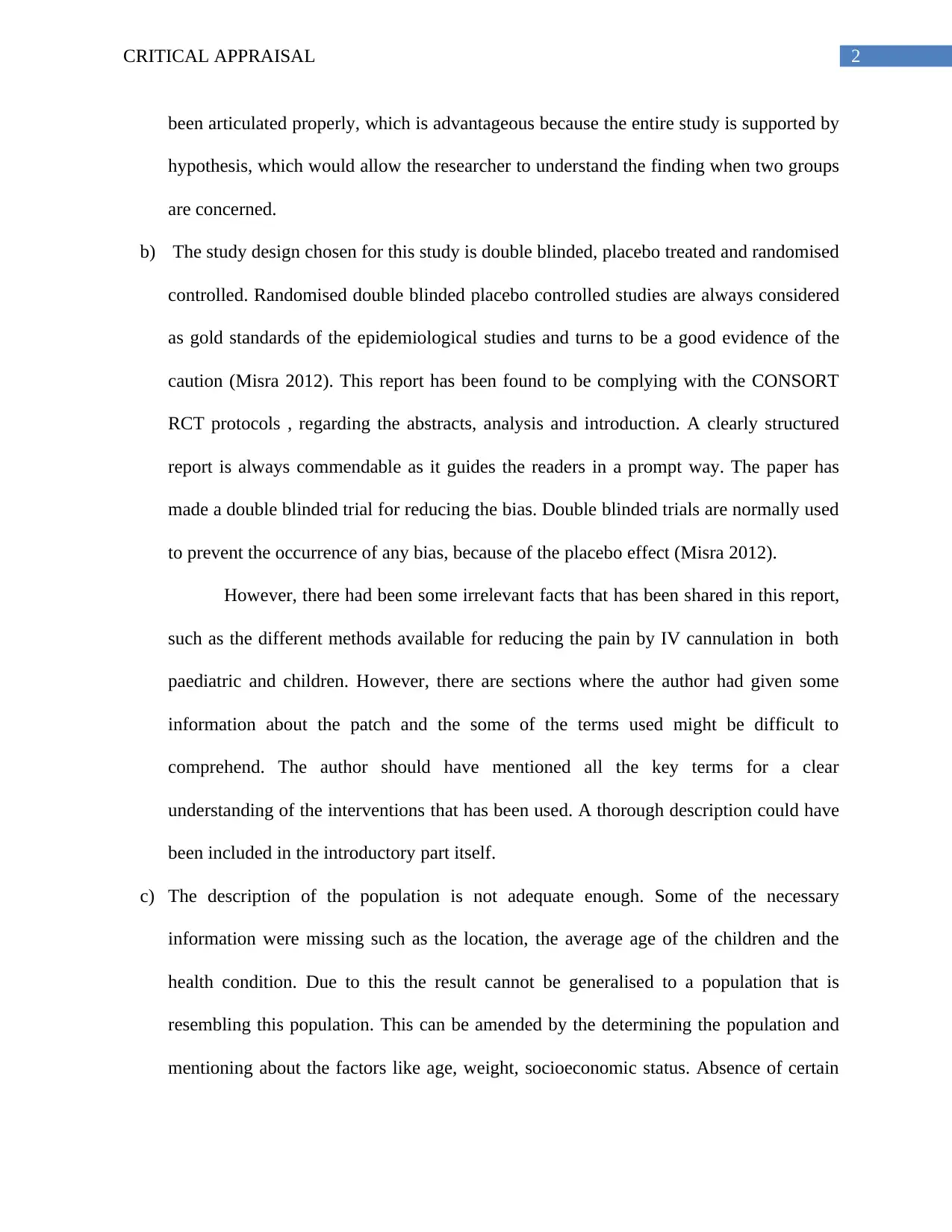
2CRITICAL APPRAISAL
been articulated properly, which is advantageous because the entire study is supported by
hypothesis, which would allow the researcher to understand the finding when two groups
are concerned.
b) The study design chosen for this study is double blinded, placebo treated and randomised
controlled. Randomised double blinded placebo controlled studies are always considered
as gold standards of the epidemiological studies and turns to be a good evidence of the
caution (Misra 2012). This report has been found to be complying with the CONSORT
RCT protocols , regarding the abstracts, analysis and introduction. A clearly structured
report is always commendable as it guides the readers in a prompt way. The paper has
made a double blinded trial for reducing the bias. Double blinded trials are normally used
to prevent the occurrence of any bias, because of the placebo effect (Misra 2012).
However, there had been some irrelevant facts that has been shared in this report,
such as the different methods available for reducing the pain by IV cannulation in both
paediatric and children. However, there are sections where the author had given some
information about the patch and the some of the terms used might be difficult to
comprehend. The author should have mentioned all the key terms for a clear
understanding of the interventions that has been used. A thorough description could have
been included in the introductory part itself.
c) The description of the population is not adequate enough. Some of the necessary
information were missing such as the location, the average age of the children and the
health condition. Due to this the result cannot be generalised to a population that is
resembling this population. This can be amended by the determining the population and
mentioning about the factors like age, weight, socioeconomic status. Absence of certain
been articulated properly, which is advantageous because the entire study is supported by
hypothesis, which would allow the researcher to understand the finding when two groups
are concerned.
b) The study design chosen for this study is double blinded, placebo treated and randomised
controlled. Randomised double blinded placebo controlled studies are always considered
as gold standards of the epidemiological studies and turns to be a good evidence of the
caution (Misra 2012). This report has been found to be complying with the CONSORT
RCT protocols , regarding the abstracts, analysis and introduction. A clearly structured
report is always commendable as it guides the readers in a prompt way. The paper has
made a double blinded trial for reducing the bias. Double blinded trials are normally used
to prevent the occurrence of any bias, because of the placebo effect (Misra 2012).
However, there had been some irrelevant facts that has been shared in this report,
such as the different methods available for reducing the pain by IV cannulation in both
paediatric and children. However, there are sections where the author had given some
information about the patch and the some of the terms used might be difficult to
comprehend. The author should have mentioned all the key terms for a clear
understanding of the interventions that has been used. A thorough description could have
been included in the introductory part itself.
c) The description of the population is not adequate enough. Some of the necessary
information were missing such as the location, the average age of the children and the
health condition. Due to this the result cannot be generalised to a population that is
resembling this population. This can be amended by the determining the population and
mentioning about the factors like age, weight, socioeconomic status. Absence of certain
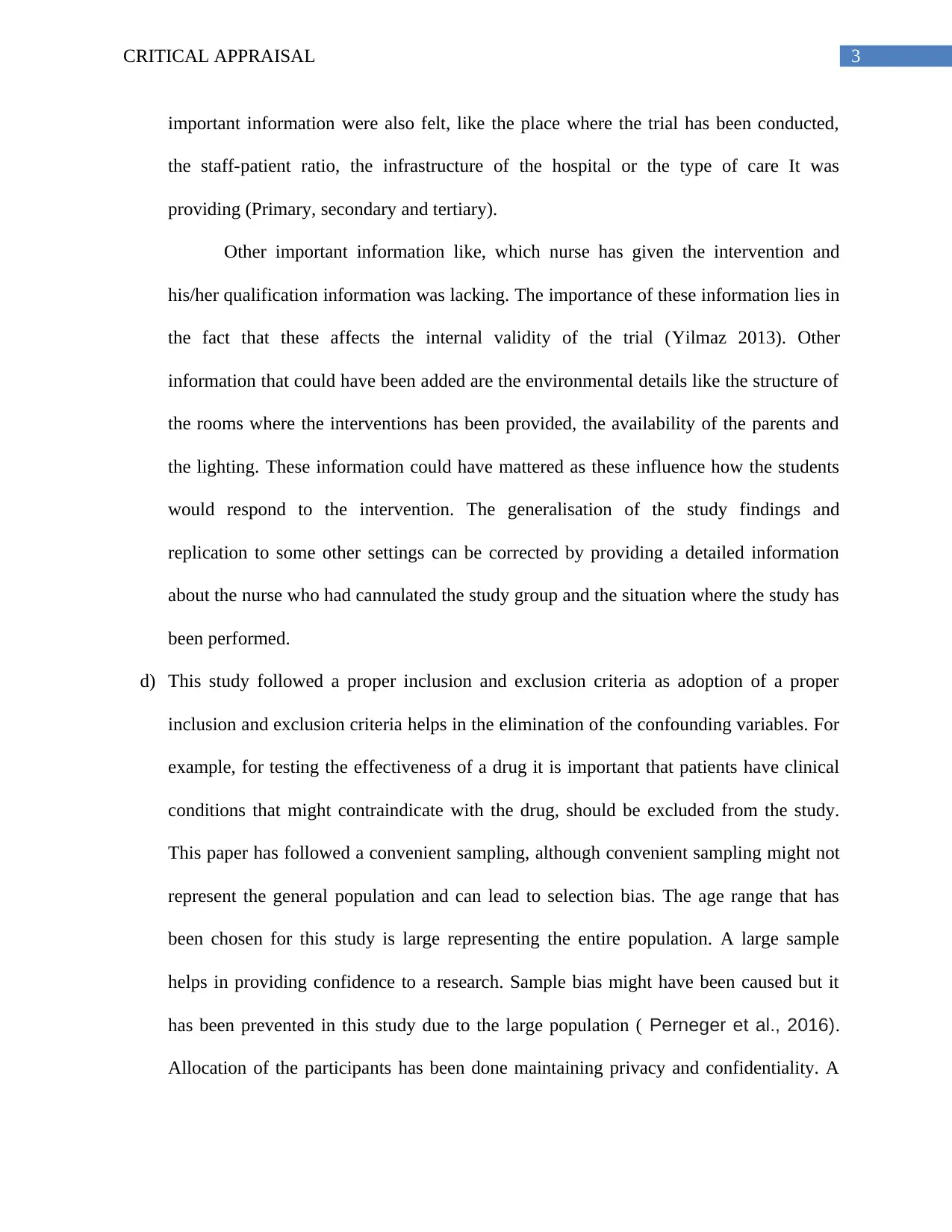
3CRITICAL APPRAISAL
important information were also felt, like the place where the trial has been conducted,
the staff-patient ratio, the infrastructure of the hospital or the type of care It was
providing (Primary, secondary and tertiary).
Other important information like, which nurse has given the intervention and
his/her qualification information was lacking. The importance of these information lies in
the fact that these affects the internal validity of the trial (Yilmaz 2013). Other
information that could have been added are the environmental details like the structure of
the rooms where the interventions has been provided, the availability of the parents and
the lighting. These information could have mattered as these influence how the students
would respond to the intervention. The generalisation of the study findings and
replication to some other settings can be corrected by providing a detailed information
about the nurse who had cannulated the study group and the situation where the study has
been performed.
d) This study followed a proper inclusion and exclusion criteria as adoption of a proper
inclusion and exclusion criteria helps in the elimination of the confounding variables. For
example, for testing the effectiveness of a drug it is important that patients have clinical
conditions that might contraindicate with the drug, should be excluded from the study.
This paper has followed a convenient sampling, although convenient sampling might not
represent the general population and can lead to selection bias. The age range that has
been chosen for this study is large representing the entire population. A large sample
helps in providing confidence to a research. Sample bias might have been caused but it
has been prevented in this study due to the large population ( Perneger et al., 2016).
Allocation of the participants has been done maintaining privacy and confidentiality. A
important information were also felt, like the place where the trial has been conducted,
the staff-patient ratio, the infrastructure of the hospital or the type of care It was
providing (Primary, secondary and tertiary).
Other important information like, which nurse has given the intervention and
his/her qualification information was lacking. The importance of these information lies in
the fact that these affects the internal validity of the trial (Yilmaz 2013). Other
information that could have been added are the environmental details like the structure of
the rooms where the interventions has been provided, the availability of the parents and
the lighting. These information could have mattered as these influence how the students
would respond to the intervention. The generalisation of the study findings and
replication to some other settings can be corrected by providing a detailed information
about the nurse who had cannulated the study group and the situation where the study has
been performed.
d) This study followed a proper inclusion and exclusion criteria as adoption of a proper
inclusion and exclusion criteria helps in the elimination of the confounding variables. For
example, for testing the effectiveness of a drug it is important that patients have clinical
conditions that might contraindicate with the drug, should be excluded from the study.
This paper has followed a convenient sampling, although convenient sampling might not
represent the general population and can lead to selection bias. The age range that has
been chosen for this study is large representing the entire population. A large sample
helps in providing confidence to a research. Sample bias might have been caused but it
has been prevented in this study due to the large population ( Perneger et al., 2016).
Allocation of the participants has been done maintaining privacy and confidentiality. A
Secure Best Marks with AI Grader
Need help grading? Try our AI Grader for instant feedback on your assignments.
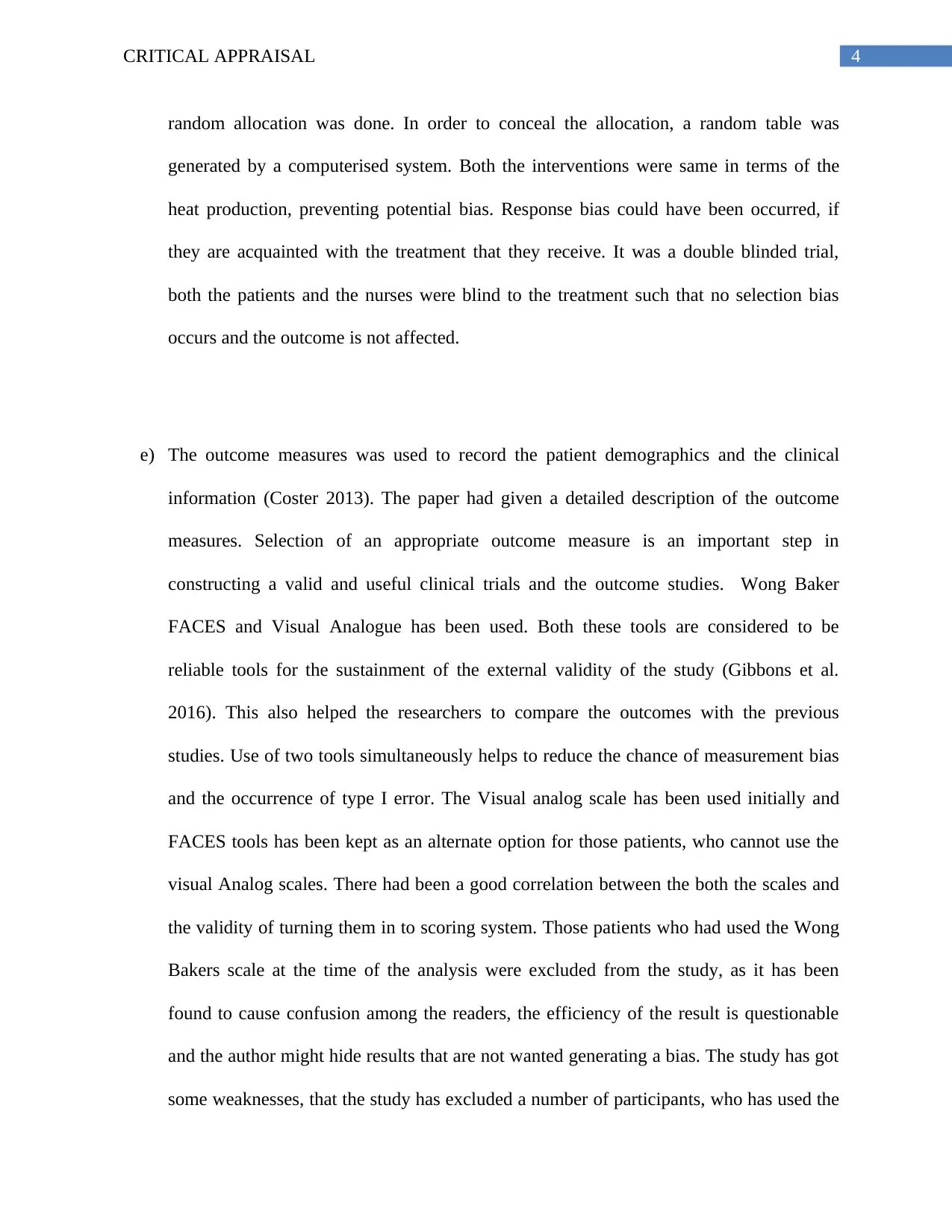
4CRITICAL APPRAISAL
random allocation was done. In order to conceal the allocation, a random table was
generated by a computerised system. Both the interventions were same in terms of the
heat production, preventing potential bias. Response bias could have been occurred, if
they are acquainted with the treatment that they receive. It was a double blinded trial,
both the patients and the nurses were blind to the treatment such that no selection bias
occurs and the outcome is not affected.
e) The outcome measures was used to record the patient demographics and the clinical
information (Coster 2013). The paper had given a detailed description of the outcome
measures. Selection of an appropriate outcome measure is an important step in
constructing a valid and useful clinical trials and the outcome studies. Wong Baker
FACES and Visual Analogue has been used. Both these tools are considered to be
reliable tools for the sustainment of the external validity of the study (Gibbons et al.
2016). This also helped the researchers to compare the outcomes with the previous
studies. Use of two tools simultaneously helps to reduce the chance of measurement bias
and the occurrence of type I error. The Visual analog scale has been used initially and
FACES tools has been kept as an alternate option for those patients, who cannot use the
visual Analog scales. There had been a good correlation between the both the scales and
the validity of turning them in to scoring system. Those patients who had used the Wong
Bakers scale at the time of the analysis were excluded from the study, as it has been
found to cause confusion among the readers, the efficiency of the result is questionable
and the author might hide results that are not wanted generating a bias. The study has got
some weaknesses, that the study has excluded a number of participants, who has used the
random allocation was done. In order to conceal the allocation, a random table was
generated by a computerised system. Both the interventions were same in terms of the
heat production, preventing potential bias. Response bias could have been occurred, if
they are acquainted with the treatment that they receive. It was a double blinded trial,
both the patients and the nurses were blind to the treatment such that no selection bias
occurs and the outcome is not affected.
e) The outcome measures was used to record the patient demographics and the clinical
information (Coster 2013). The paper had given a detailed description of the outcome
measures. Selection of an appropriate outcome measure is an important step in
constructing a valid and useful clinical trials and the outcome studies. Wong Baker
FACES and Visual Analogue has been used. Both these tools are considered to be
reliable tools for the sustainment of the external validity of the study (Gibbons et al.
2016). This also helped the researchers to compare the outcomes with the previous
studies. Use of two tools simultaneously helps to reduce the chance of measurement bias
and the occurrence of type I error. The Visual analog scale has been used initially and
FACES tools has been kept as an alternate option for those patients, who cannot use the
visual Analog scales. There had been a good correlation between the both the scales and
the validity of turning them in to scoring system. Those patients who had used the Wong
Bakers scale at the time of the analysis were excluded from the study, as it has been
found to cause confusion among the readers, the efficiency of the result is questionable
and the author might hide results that are not wanted generating a bias. The study has got
some weaknesses, that the study has excluded a number of participants, who has used the
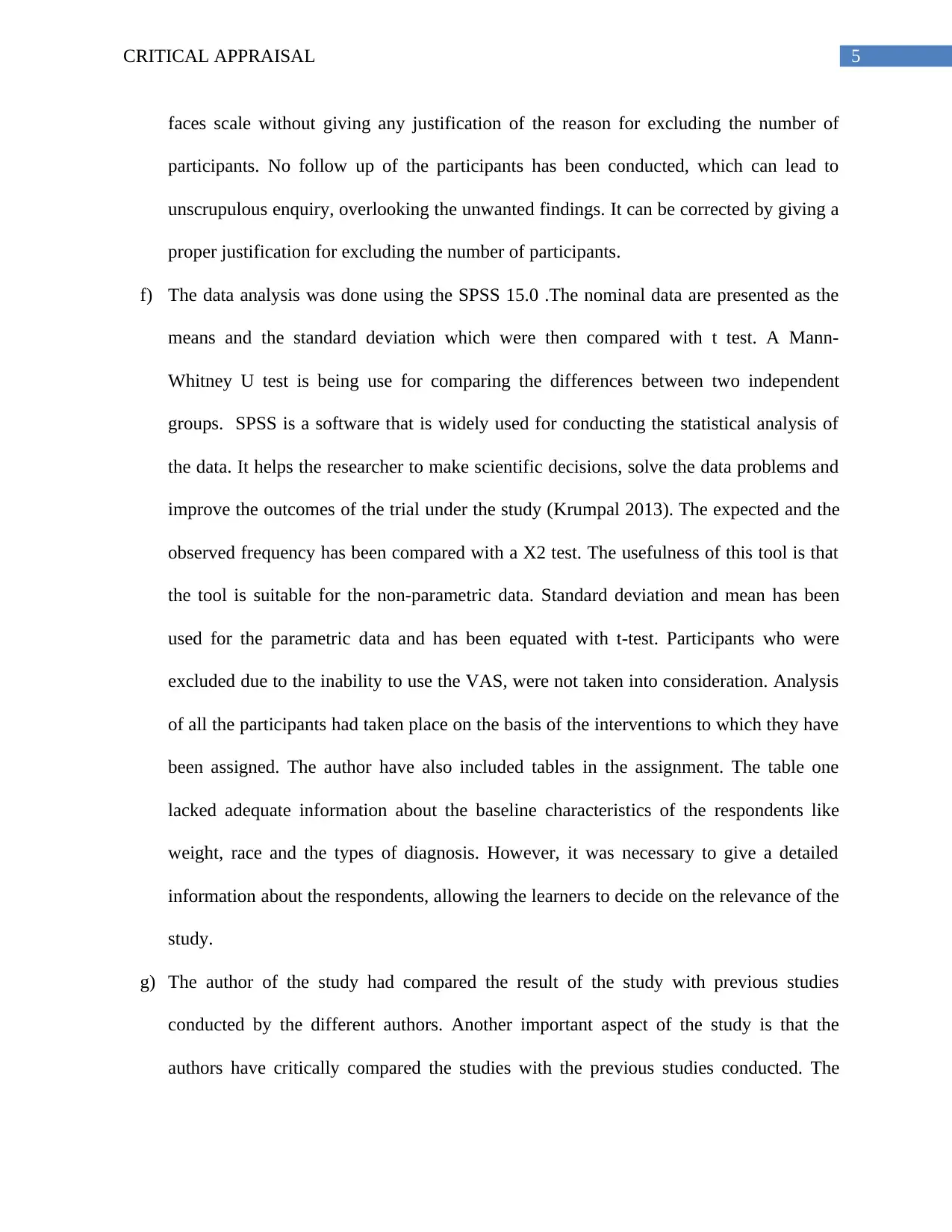
5CRITICAL APPRAISAL
faces scale without giving any justification of the reason for excluding the number of
participants. No follow up of the participants has been conducted, which can lead to
unscrupulous enquiry, overlooking the unwanted findings. It can be corrected by giving a
proper justification for excluding the number of participants.
f) The data analysis was done using the SPSS 15.0 .The nominal data are presented as the
means and the standard deviation which were then compared with t test. A Mann-
Whitney U test is being use for comparing the differences between two independent
groups. SPSS is a software that is widely used for conducting the statistical analysis of
the data. It helps the researcher to make scientific decisions, solve the data problems and
improve the outcomes of the trial under the study (Krumpal 2013). The expected and the
observed frequency has been compared with a X2 test. The usefulness of this tool is that
the tool is suitable for the non-parametric data. Standard deviation and mean has been
used for the parametric data and has been equated with t-test. Participants who were
excluded due to the inability to use the VAS, were not taken into consideration. Analysis
of all the participants had taken place on the basis of the interventions to which they have
been assigned. The author have also included tables in the assignment. The table one
lacked adequate information about the baseline characteristics of the respondents like
weight, race and the types of diagnosis. However, it was necessary to give a detailed
information about the respondents, allowing the learners to decide on the relevance of the
study.
g) The author of the study had compared the result of the study with previous studies
conducted by the different authors. Another important aspect of the study is that the
authors have critically compared the studies with the previous studies conducted. The
faces scale without giving any justification of the reason for excluding the number of
participants. No follow up of the participants has been conducted, which can lead to
unscrupulous enquiry, overlooking the unwanted findings. It can be corrected by giving a
proper justification for excluding the number of participants.
f) The data analysis was done using the SPSS 15.0 .The nominal data are presented as the
means and the standard deviation which were then compared with t test. A Mann-
Whitney U test is being use for comparing the differences between two independent
groups. SPSS is a software that is widely used for conducting the statistical analysis of
the data. It helps the researcher to make scientific decisions, solve the data problems and
improve the outcomes of the trial under the study (Krumpal 2013). The expected and the
observed frequency has been compared with a X2 test. The usefulness of this tool is that
the tool is suitable for the non-parametric data. Standard deviation and mean has been
used for the parametric data and has been equated with t-test. Participants who were
excluded due to the inability to use the VAS, were not taken into consideration. Analysis
of all the participants had taken place on the basis of the interventions to which they have
been assigned. The author have also included tables in the assignment. The table one
lacked adequate information about the baseline characteristics of the respondents like
weight, race and the types of diagnosis. However, it was necessary to give a detailed
information about the respondents, allowing the learners to decide on the relevance of the
study.
g) The author of the study had compared the result of the study with previous studies
conducted by the different authors. Another important aspect of the study is that the
authors have critically compared the studies with the previous studies conducted. The
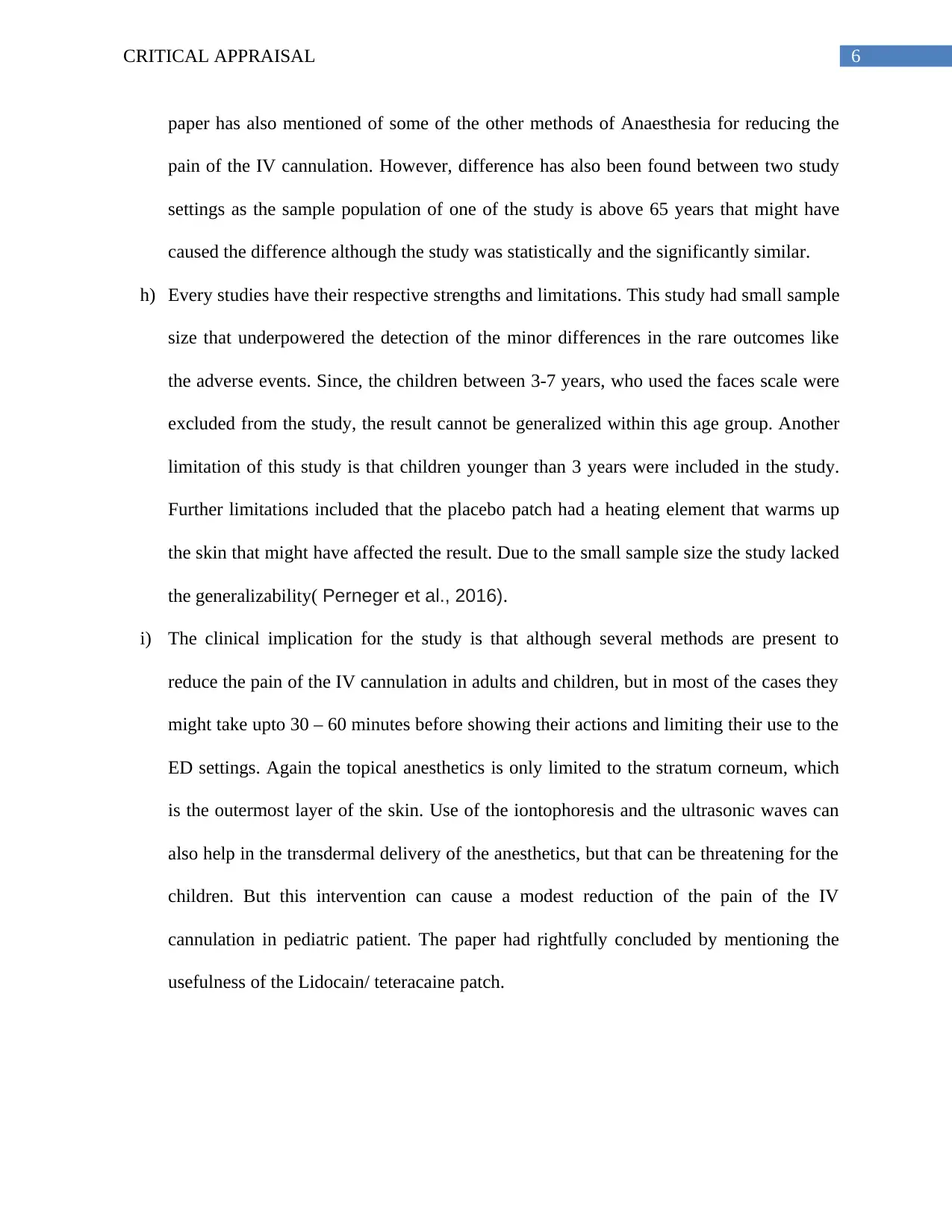
6CRITICAL APPRAISAL
paper has also mentioned of some of the other methods of Anaesthesia for reducing the
pain of the IV cannulation. However, difference has also been found between two study
settings as the sample population of one of the study is above 65 years that might have
caused the difference although the study was statistically and the significantly similar.
h) Every studies have their respective strengths and limitations. This study had small sample
size that underpowered the detection of the minor differences in the rare outcomes like
the adverse events. Since, the children between 3-7 years, who used the faces scale were
excluded from the study, the result cannot be generalized within this age group. Another
limitation of this study is that children younger than 3 years were included in the study.
Further limitations included that the placebo patch had a heating element that warms up
the skin that might have affected the result. Due to the small sample size the study lacked
the generalizability( Perneger et al., 2016).
i) The clinical implication for the study is that although several methods are present to
reduce the pain of the IV cannulation in adults and children, but in most of the cases they
might take upto 30 – 60 minutes before showing their actions and limiting their use to the
ED settings. Again the topical anesthetics is only limited to the stratum corneum, which
is the outermost layer of the skin. Use of the iontophoresis and the ultrasonic waves can
also help in the transdermal delivery of the anesthetics, but that can be threatening for the
children. But this intervention can cause a modest reduction of the pain of the IV
cannulation in pediatric patient. The paper had rightfully concluded by mentioning the
usefulness of the Lidocain/ teteracaine patch.
paper has also mentioned of some of the other methods of Anaesthesia for reducing the
pain of the IV cannulation. However, difference has also been found between two study
settings as the sample population of one of the study is above 65 years that might have
caused the difference although the study was statistically and the significantly similar.
h) Every studies have their respective strengths and limitations. This study had small sample
size that underpowered the detection of the minor differences in the rare outcomes like
the adverse events. Since, the children between 3-7 years, who used the faces scale were
excluded from the study, the result cannot be generalized within this age group. Another
limitation of this study is that children younger than 3 years were included in the study.
Further limitations included that the placebo patch had a heating element that warms up
the skin that might have affected the result. Due to the small sample size the study lacked
the generalizability( Perneger et al., 2016).
i) The clinical implication for the study is that although several methods are present to
reduce the pain of the IV cannulation in adults and children, but in most of the cases they
might take upto 30 – 60 minutes before showing their actions and limiting their use to the
ED settings. Again the topical anesthetics is only limited to the stratum corneum, which
is the outermost layer of the skin. Use of the iontophoresis and the ultrasonic waves can
also help in the transdermal delivery of the anesthetics, but that can be threatening for the
children. But this intervention can cause a modest reduction of the pain of the IV
cannulation in pediatric patient. The paper had rightfully concluded by mentioning the
usefulness of the Lidocain/ teteracaine patch.
Paraphrase This Document
Need a fresh take? Get an instant paraphrase of this document with our AI Paraphraser
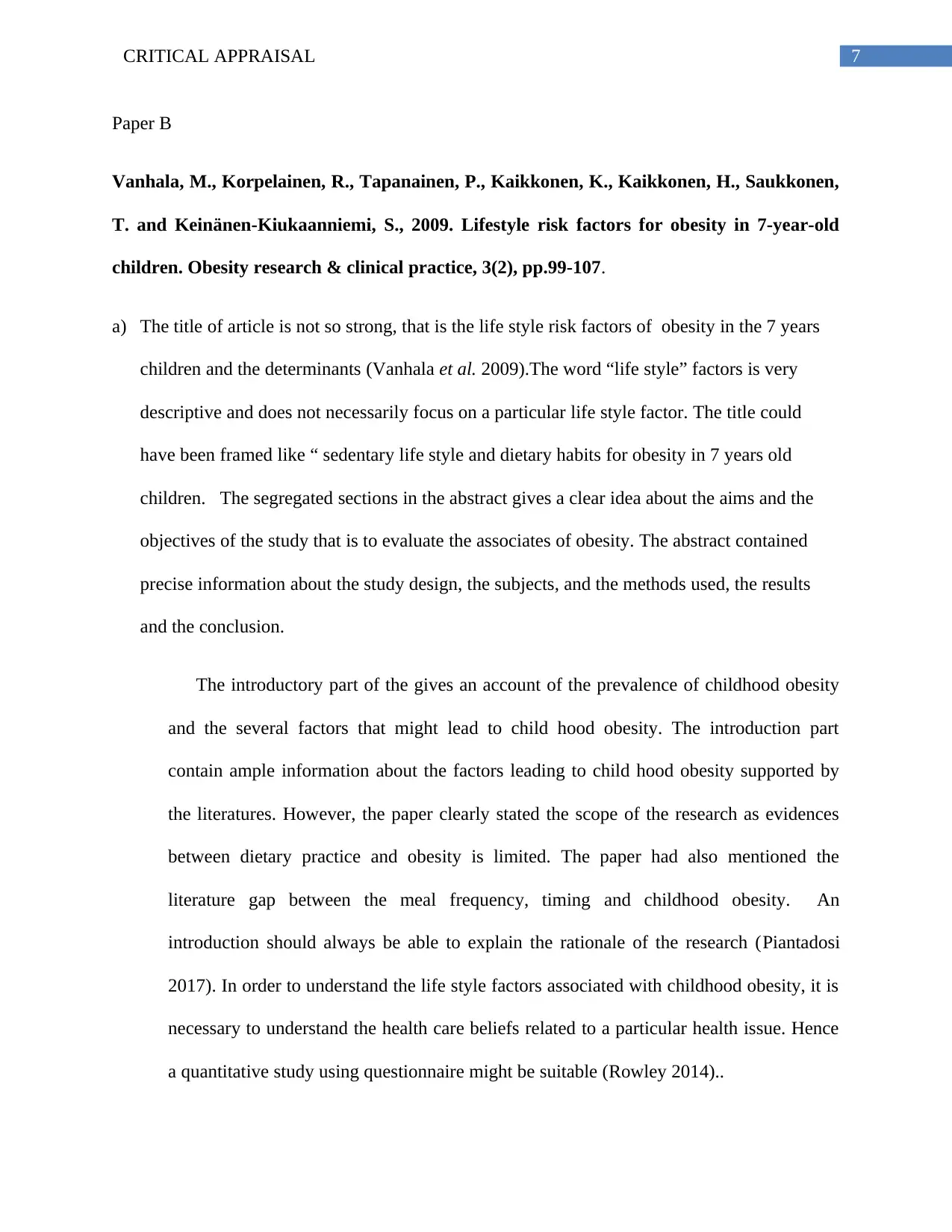
7CRITICAL APPRAISAL
Paper B
Vanhala, M., Korpelainen, R., Tapanainen, P., Kaikkonen, K., Kaikkonen, H., Saukkonen,
T. and Keinänen-Kiukaanniemi, S., 2009. Lifestyle risk factors for obesity in 7-year-old
children. Obesity research & clinical practice, 3(2), pp.99-107.
a) The title of article is not so strong, that is the life style risk factors of obesity in the 7 years
children and the determinants (Vanhala et al. 2009).The word “life style” factors is very
descriptive and does not necessarily focus on a particular life style factor. The title could
have been framed like “ sedentary life style and dietary habits for obesity in 7 years old
children. The segregated sections in the abstract gives a clear idea about the aims and the
objectives of the study that is to evaluate the associates of obesity. The abstract contained
precise information about the study design, the subjects, and the methods used, the results
and the conclusion.
The introductory part of the gives an account of the prevalence of childhood obesity
and the several factors that might lead to child hood obesity. The introduction part
contain ample information about the factors leading to child hood obesity supported by
the literatures. However, the paper clearly stated the scope of the research as evidences
between dietary practice and obesity is limited. The paper had also mentioned the
literature gap between the meal frequency, timing and childhood obesity. An
introduction should always be able to explain the rationale of the research (Piantadosi
2017). In order to understand the life style factors associated with childhood obesity, it is
necessary to understand the health care beliefs related to a particular health issue. Hence
a quantitative study using questionnaire might be suitable (Rowley 2014)..
Paper B
Vanhala, M., Korpelainen, R., Tapanainen, P., Kaikkonen, K., Kaikkonen, H., Saukkonen,
T. and Keinänen-Kiukaanniemi, S., 2009. Lifestyle risk factors for obesity in 7-year-old
children. Obesity research & clinical practice, 3(2), pp.99-107.
a) The title of article is not so strong, that is the life style risk factors of obesity in the 7 years
children and the determinants (Vanhala et al. 2009).The word “life style” factors is very
descriptive and does not necessarily focus on a particular life style factor. The title could
have been framed like “ sedentary life style and dietary habits for obesity in 7 years old
children. The segregated sections in the abstract gives a clear idea about the aims and the
objectives of the study that is to evaluate the associates of obesity. The abstract contained
precise information about the study design, the subjects, and the methods used, the results
and the conclusion.
The introductory part of the gives an account of the prevalence of childhood obesity
and the several factors that might lead to child hood obesity. The introduction part
contain ample information about the factors leading to child hood obesity supported by
the literatures. However, the paper clearly stated the scope of the research as evidences
between dietary practice and obesity is limited. The paper had also mentioned the
literature gap between the meal frequency, timing and childhood obesity. An
introduction should always be able to explain the rationale of the research (Piantadosi
2017). In order to understand the life style factors associated with childhood obesity, it is
necessary to understand the health care beliefs related to a particular health issue. Hence
a quantitative study using questionnaire might be suitable (Rowley 2014)..
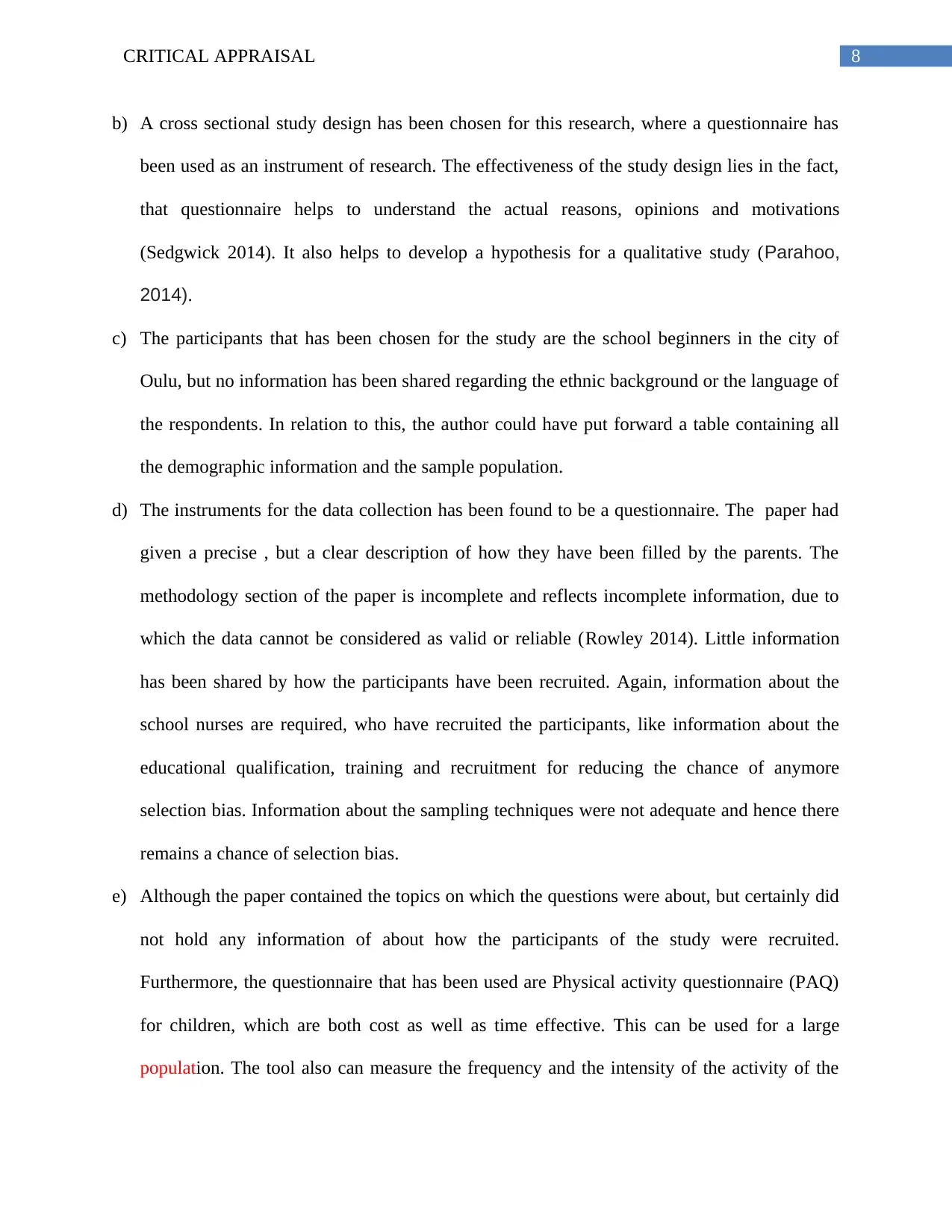
8CRITICAL APPRAISAL
b) A cross sectional study design has been chosen for this research, where a questionnaire has
been used as an instrument of research. The effectiveness of the study design lies in the fact,
that questionnaire helps to understand the actual reasons, opinions and motivations
(Sedgwick 2014). It also helps to develop a hypothesis for a qualitative study (Parahoo,
2014).
c) The participants that has been chosen for the study are the school beginners in the city of
Oulu, but no information has been shared regarding the ethnic background or the language of
the respondents. In relation to this, the author could have put forward a table containing all
the demographic information and the sample population.
d) The instruments for the data collection has been found to be a questionnaire. The paper had
given a precise , but a clear description of how they have been filled by the parents. The
methodology section of the paper is incomplete and reflects incomplete information, due to
which the data cannot be considered as valid or reliable (Rowley 2014). Little information
has been shared by how the participants have been recruited. Again, information about the
school nurses are required, who have recruited the participants, like information about the
educational qualification, training and recruitment for reducing the chance of anymore
selection bias. Information about the sampling techniques were not adequate and hence there
remains a chance of selection bias.
e) Although the paper contained the topics on which the questions were about, but certainly did
not hold any information of about how the participants of the study were recruited.
Furthermore, the questionnaire that has been used are Physical activity questionnaire (PAQ)
for children, which are both cost as well as time effective. This can be used for a large
population. The tool also can measure the frequency and the intensity of the activity of the
b) A cross sectional study design has been chosen for this research, where a questionnaire has
been used as an instrument of research. The effectiveness of the study design lies in the fact,
that questionnaire helps to understand the actual reasons, opinions and motivations
(Sedgwick 2014). It also helps to develop a hypothesis for a qualitative study (Parahoo,
2014).
c) The participants that has been chosen for the study are the school beginners in the city of
Oulu, but no information has been shared regarding the ethnic background or the language of
the respondents. In relation to this, the author could have put forward a table containing all
the demographic information and the sample population.
d) The instruments for the data collection has been found to be a questionnaire. The paper had
given a precise , but a clear description of how they have been filled by the parents. The
methodology section of the paper is incomplete and reflects incomplete information, due to
which the data cannot be considered as valid or reliable (Rowley 2014). Little information
has been shared by how the participants have been recruited. Again, information about the
school nurses are required, who have recruited the participants, like information about the
educational qualification, training and recruitment for reducing the chance of anymore
selection bias. Information about the sampling techniques were not adequate and hence there
remains a chance of selection bias.
e) Although the paper contained the topics on which the questions were about, but certainly did
not hold any information of about how the participants of the study were recruited.
Furthermore, the questionnaire that has been used are Physical activity questionnaire (PAQ)
for children, which are both cost as well as time effective. This can be used for a large
population. The tool also can measure the frequency and the intensity of the activity of the
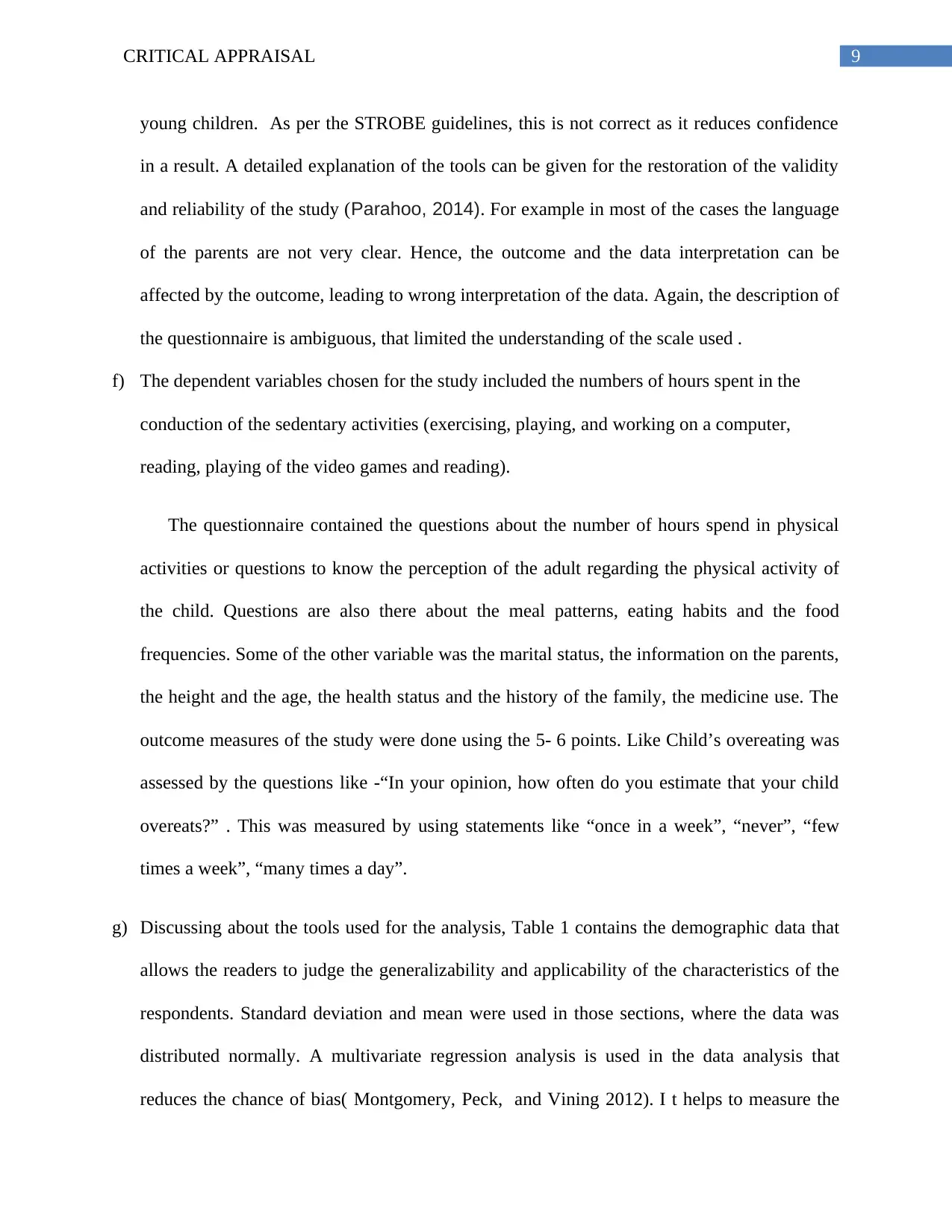
9CRITICAL APPRAISAL
young children. As per the STROBE guidelines, this is not correct as it reduces confidence
in a result. A detailed explanation of the tools can be given for the restoration of the validity
and reliability of the study (Parahoo, 2014). For example in most of the cases the language
of the parents are not very clear. Hence, the outcome and the data interpretation can be
affected by the outcome, leading to wrong interpretation of the data. Again, the description of
the questionnaire is ambiguous, that limited the understanding of the scale used .
f) The dependent variables chosen for the study included the numbers of hours spent in the
conduction of the sedentary activities (exercising, playing, and working on a computer,
reading, playing of the video games and reading).
The questionnaire contained the questions about the number of hours spend in physical
activities or questions to know the perception of the adult regarding the physical activity of
the child. Questions are also there about the meal patterns, eating habits and the food
frequencies. Some of the other variable was the marital status, the information on the parents,
the height and the age, the health status and the history of the family, the medicine use. The
outcome measures of the study were done using the 5- 6 points. Like Child’s overeating was
assessed by the questions like -“In your opinion, how often do you estimate that your child
overeats?” . This was measured by using statements like “once in a week”, “never”, “few
times a week”, “many times a day”.
g) Discussing about the tools used for the analysis, Table 1 contains the demographic data that
allows the readers to judge the generalizability and applicability of the characteristics of the
respondents. Standard deviation and mean were used in those sections, where the data was
distributed normally. A multivariate regression analysis is used in the data analysis that
reduces the chance of bias( Montgomery, Peck, and Vining 2012). I t helps to measure the
young children. As per the STROBE guidelines, this is not correct as it reduces confidence
in a result. A detailed explanation of the tools can be given for the restoration of the validity
and reliability of the study (Parahoo, 2014). For example in most of the cases the language
of the parents are not very clear. Hence, the outcome and the data interpretation can be
affected by the outcome, leading to wrong interpretation of the data. Again, the description of
the questionnaire is ambiguous, that limited the understanding of the scale used .
f) The dependent variables chosen for the study included the numbers of hours spent in the
conduction of the sedentary activities (exercising, playing, and working on a computer,
reading, playing of the video games and reading).
The questionnaire contained the questions about the number of hours spend in physical
activities or questions to know the perception of the adult regarding the physical activity of
the child. Questions are also there about the meal patterns, eating habits and the food
frequencies. Some of the other variable was the marital status, the information on the parents,
the height and the age, the health status and the history of the family, the medicine use. The
outcome measures of the study were done using the 5- 6 points. Like Child’s overeating was
assessed by the questions like -“In your opinion, how often do you estimate that your child
overeats?” . This was measured by using statements like “once in a week”, “never”, “few
times a week”, “many times a day”.
g) Discussing about the tools used for the analysis, Table 1 contains the demographic data that
allows the readers to judge the generalizability and applicability of the characteristics of the
respondents. Standard deviation and mean were used in those sections, where the data was
distributed normally. A multivariate regression analysis is used in the data analysis that
reduces the chance of bias( Montgomery, Peck, and Vining 2012). I t helps to measure the
Secure Best Marks with AI Grader
Need help grading? Try our AI Grader for instant feedback on your assignments.
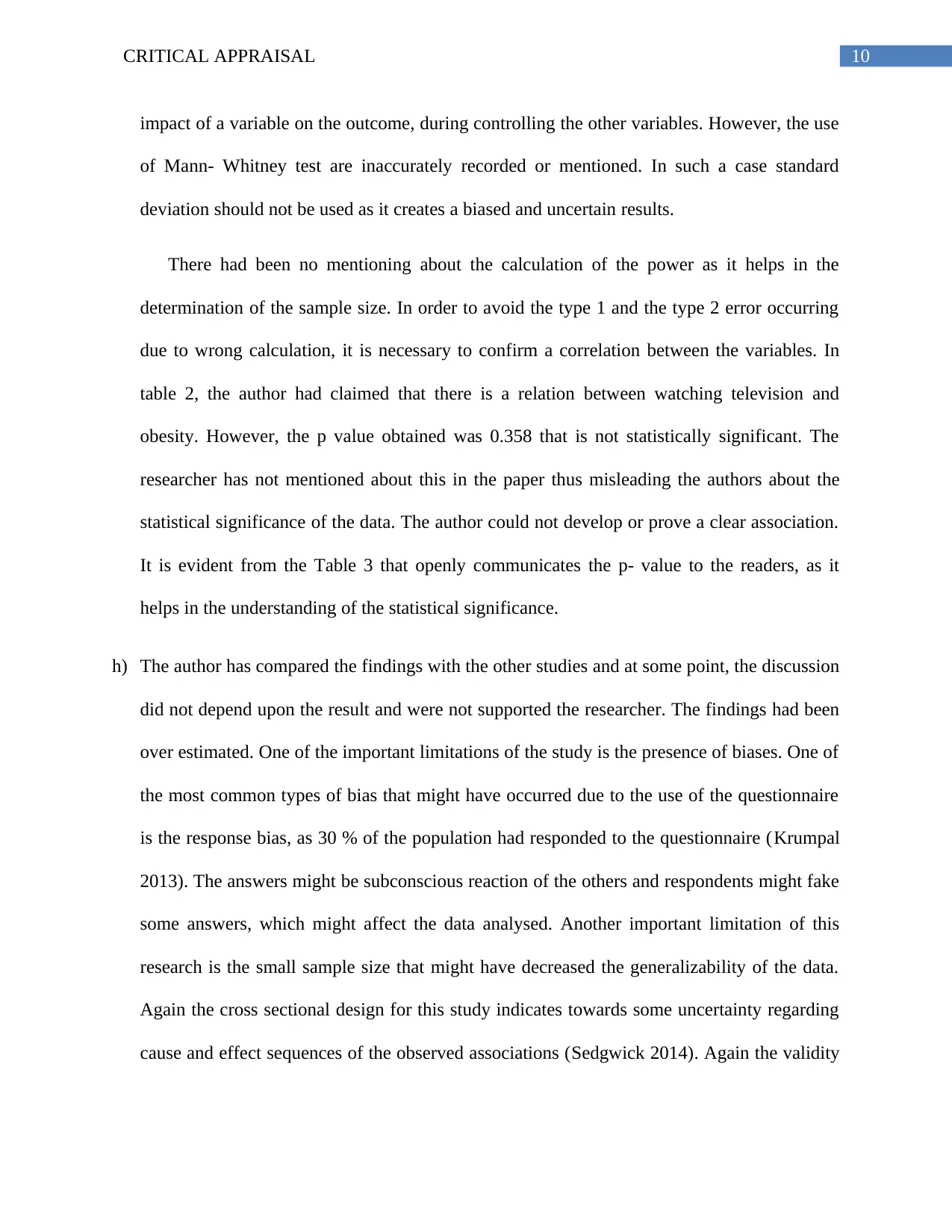
10CRITICAL APPRAISAL
impact of a variable on the outcome, during controlling the other variables. However, the use
of Mann- Whitney test are inaccurately recorded or mentioned. In such a case standard
deviation should not be used as it creates a biased and uncertain results.
There had been no mentioning about the calculation of the power as it helps in the
determination of the sample size. In order to avoid the type 1 and the type 2 error occurring
due to wrong calculation, it is necessary to confirm a correlation between the variables. In
table 2, the author had claimed that there is a relation between watching television and
obesity. However, the p value obtained was 0.358 that is not statistically significant. The
researcher has not mentioned about this in the paper thus misleading the authors about the
statistical significance of the data. The author could not develop or prove a clear association.
It is evident from the Table 3 that openly communicates the p- value to the readers, as it
helps in the understanding of the statistical significance.
h) The author has compared the findings with the other studies and at some point, the discussion
did not depend upon the result and were not supported the researcher. The findings had been
over estimated. One of the important limitations of the study is the presence of biases. One of
the most common types of bias that might have occurred due to the use of the questionnaire
is the response bias, as 30 % of the population had responded to the questionnaire (Krumpal
2013). The answers might be subconscious reaction of the others and respondents might fake
some answers, which might affect the data analysed. Another important limitation of this
research is the small sample size that might have decreased the generalizability of the data.
Again the cross sectional design for this study indicates towards some uncertainty regarding
cause and effect sequences of the observed associations (Sedgwick 2014). Again the validity
impact of a variable on the outcome, during controlling the other variables. However, the use
of Mann- Whitney test are inaccurately recorded or mentioned. In such a case standard
deviation should not be used as it creates a biased and uncertain results.
There had been no mentioning about the calculation of the power as it helps in the
determination of the sample size. In order to avoid the type 1 and the type 2 error occurring
due to wrong calculation, it is necessary to confirm a correlation between the variables. In
table 2, the author had claimed that there is a relation between watching television and
obesity. However, the p value obtained was 0.358 that is not statistically significant. The
researcher has not mentioned about this in the paper thus misleading the authors about the
statistical significance of the data. The author could not develop or prove a clear association.
It is evident from the Table 3 that openly communicates the p- value to the readers, as it
helps in the understanding of the statistical significance.
h) The author has compared the findings with the other studies and at some point, the discussion
did not depend upon the result and were not supported the researcher. The findings had been
over estimated. One of the important limitations of the study is the presence of biases. One of
the most common types of bias that might have occurred due to the use of the questionnaire
is the response bias, as 30 % of the population had responded to the questionnaire (Krumpal
2013). The answers might be subconscious reaction of the others and respondents might fake
some answers, which might affect the data analysed. Another important limitation of this
research is the small sample size that might have decreased the generalizability of the data.
Again the cross sectional design for this study indicates towards some uncertainty regarding
cause and effect sequences of the observed associations (Sedgwick 2014). Again the validity
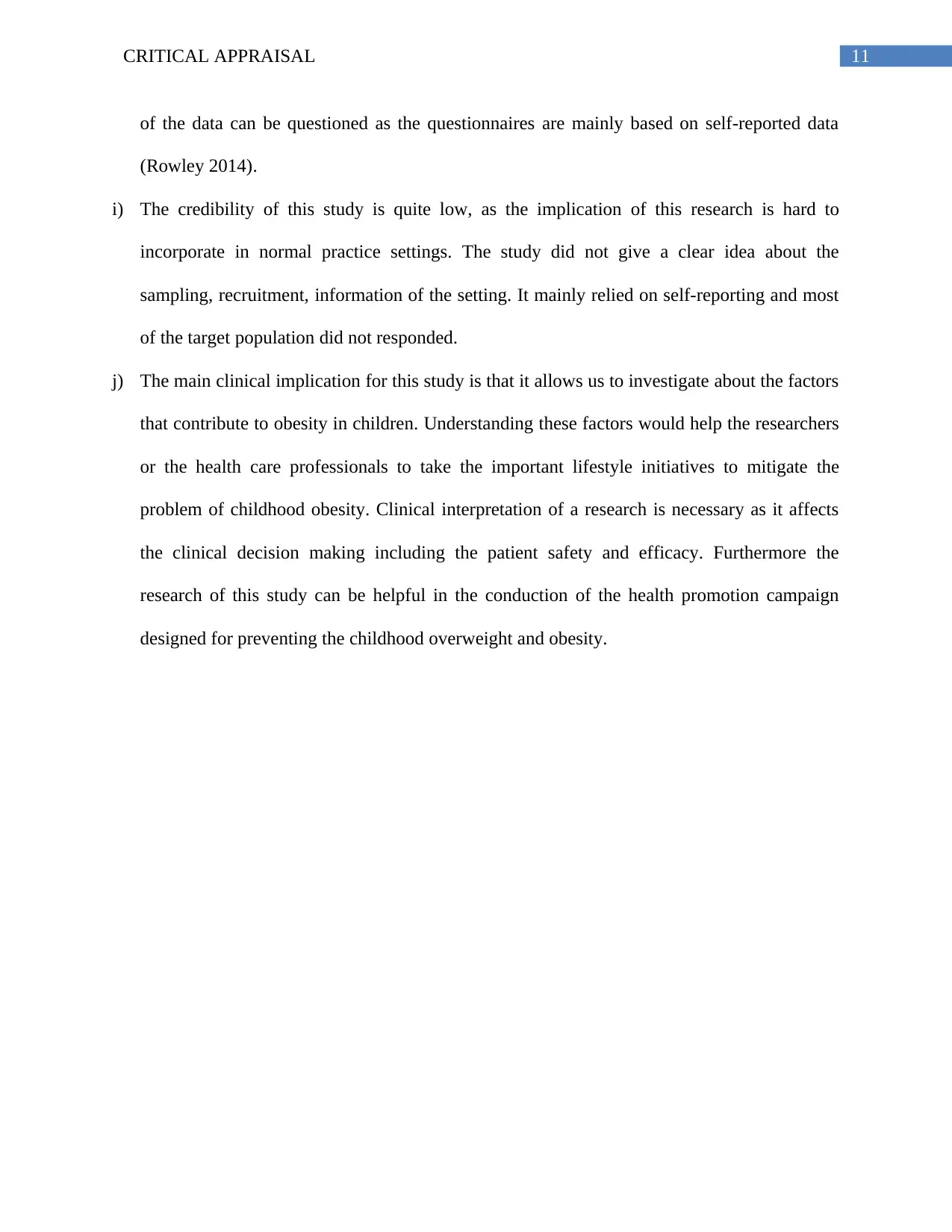
11CRITICAL APPRAISAL
of the data can be questioned as the questionnaires are mainly based on self-reported data
(Rowley 2014).
i) The credibility of this study is quite low, as the implication of this research is hard to
incorporate in normal practice settings. The study did not give a clear idea about the
sampling, recruitment, information of the setting. It mainly relied on self-reporting and most
of the target population did not responded.
j) The main clinical implication for this study is that it allows us to investigate about the factors
that contribute to obesity in children. Understanding these factors would help the researchers
or the health care professionals to take the important lifestyle initiatives to mitigate the
problem of childhood obesity. Clinical interpretation of a research is necessary as it affects
the clinical decision making including the patient safety and efficacy. Furthermore the
research of this study can be helpful in the conduction of the health promotion campaign
designed for preventing the childhood overweight and obesity.
of the data can be questioned as the questionnaires are mainly based on self-reported data
(Rowley 2014).
i) The credibility of this study is quite low, as the implication of this research is hard to
incorporate in normal practice settings. The study did not give a clear idea about the
sampling, recruitment, information of the setting. It mainly relied on self-reporting and most
of the target population did not responded.
j) The main clinical implication for this study is that it allows us to investigate about the factors
that contribute to obesity in children. Understanding these factors would help the researchers
or the health care professionals to take the important lifestyle initiatives to mitigate the
problem of childhood obesity. Clinical interpretation of a research is necessary as it affects
the clinical decision making including the patient safety and efficacy. Furthermore the
research of this study can be helpful in the conduction of the health promotion campaign
designed for preventing the childhood overweight and obesity.
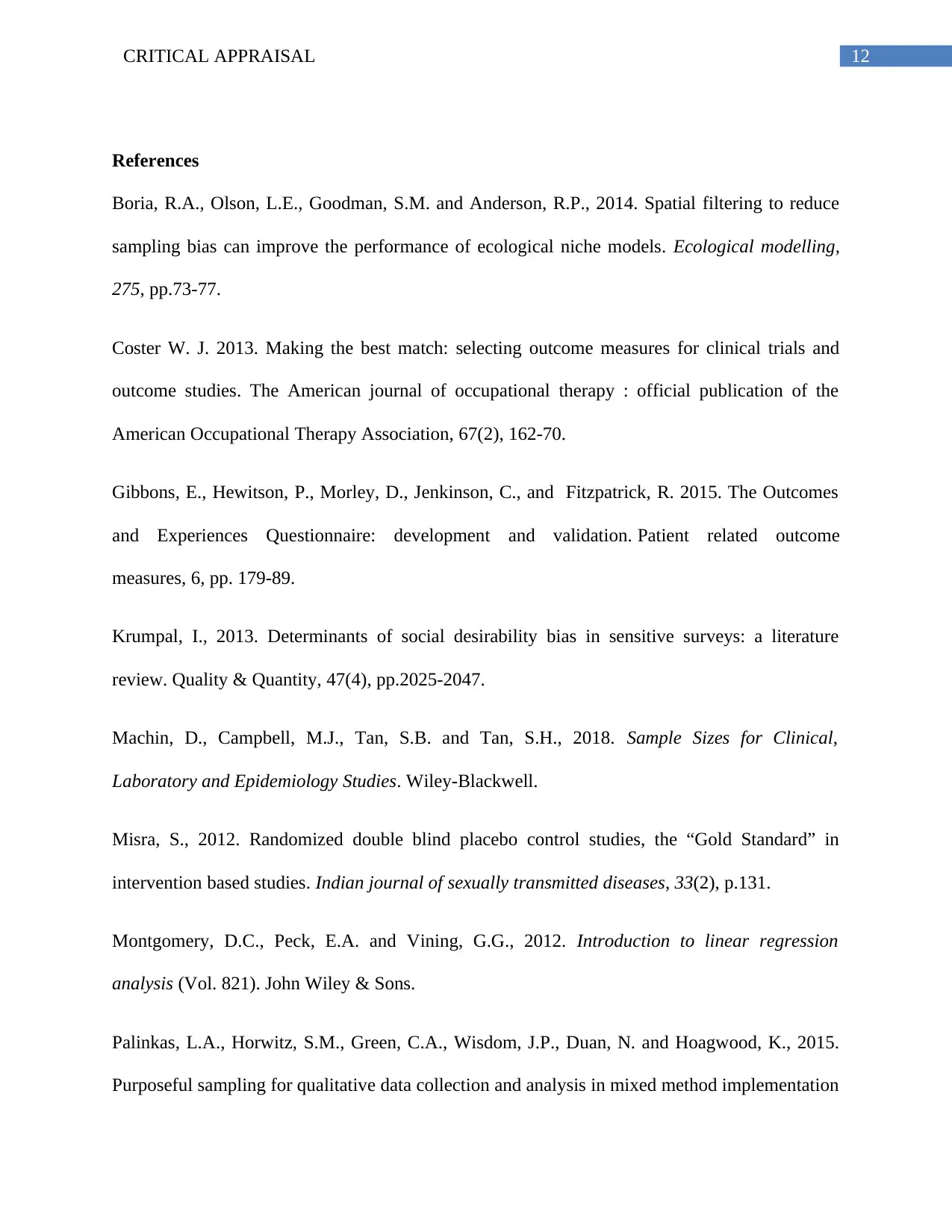
12CRITICAL APPRAISAL
References
Boria, R.A., Olson, L.E., Goodman, S.M. and Anderson, R.P., 2014. Spatial filtering to reduce
sampling bias can improve the performance of ecological niche models. Ecological modelling,
275, pp.73-77.
Coster W. J. 2013. Making the best match: selecting outcome measures for clinical trials and
outcome studies. The American journal of occupational therapy : official publication of the
American Occupational Therapy Association, 67(2), 162-70.
Gibbons, E., Hewitson, P., Morley, D., Jenkinson, C., and Fitzpatrick, R. 2015. The Outcomes
and Experiences Questionnaire: development and validation. Patient related outcome
measures, 6, pp. 179-89.
Krumpal, I., 2013. Determinants of social desirability bias in sensitive surveys: a literature
review. Quality & Quantity, 47(4), pp.2025-2047.
Machin, D., Campbell, M.J., Tan, S.B. and Tan, S.H., 2018. Sample Sizes for Clinical,
Laboratory and Epidemiology Studies. Wiley-Blackwell.
Misra, S., 2012. Randomized double blind placebo control studies, the “Gold Standard” in
intervention based studies. Indian journal of sexually transmitted diseases, 33(2), p.131.
Montgomery, D.C., Peck, E.A. and Vining, G.G., 2012. Introduction to linear regression
analysis (Vol. 821). John Wiley & Sons.
Palinkas, L.A., Horwitz, S.M., Green, C.A., Wisdom, J.P., Duan, N. and Hoagwood, K., 2015.
Purposeful sampling for qualitative data collection and analysis in mixed method implementation
References
Boria, R.A., Olson, L.E., Goodman, S.M. and Anderson, R.P., 2014. Spatial filtering to reduce
sampling bias can improve the performance of ecological niche models. Ecological modelling,
275, pp.73-77.
Coster W. J. 2013. Making the best match: selecting outcome measures for clinical trials and
outcome studies. The American journal of occupational therapy : official publication of the
American Occupational Therapy Association, 67(2), 162-70.
Gibbons, E., Hewitson, P., Morley, D., Jenkinson, C., and Fitzpatrick, R. 2015. The Outcomes
and Experiences Questionnaire: development and validation. Patient related outcome
measures, 6, pp. 179-89.
Krumpal, I., 2013. Determinants of social desirability bias in sensitive surveys: a literature
review. Quality & Quantity, 47(4), pp.2025-2047.
Machin, D., Campbell, M.J., Tan, S.B. and Tan, S.H., 2018. Sample Sizes for Clinical,
Laboratory and Epidemiology Studies. Wiley-Blackwell.
Misra, S., 2012. Randomized double blind placebo control studies, the “Gold Standard” in
intervention based studies. Indian journal of sexually transmitted diseases, 33(2), p.131.
Montgomery, D.C., Peck, E.A. and Vining, G.G., 2012. Introduction to linear regression
analysis (Vol. 821). John Wiley & Sons.
Palinkas, L.A., Horwitz, S.M., Green, C.A., Wisdom, J.P., Duan, N. and Hoagwood, K., 2015.
Purposeful sampling for qualitative data collection and analysis in mixed method implementation
Paraphrase This Document
Need a fresh take? Get an instant paraphrase of this document with our AI Paraphraser
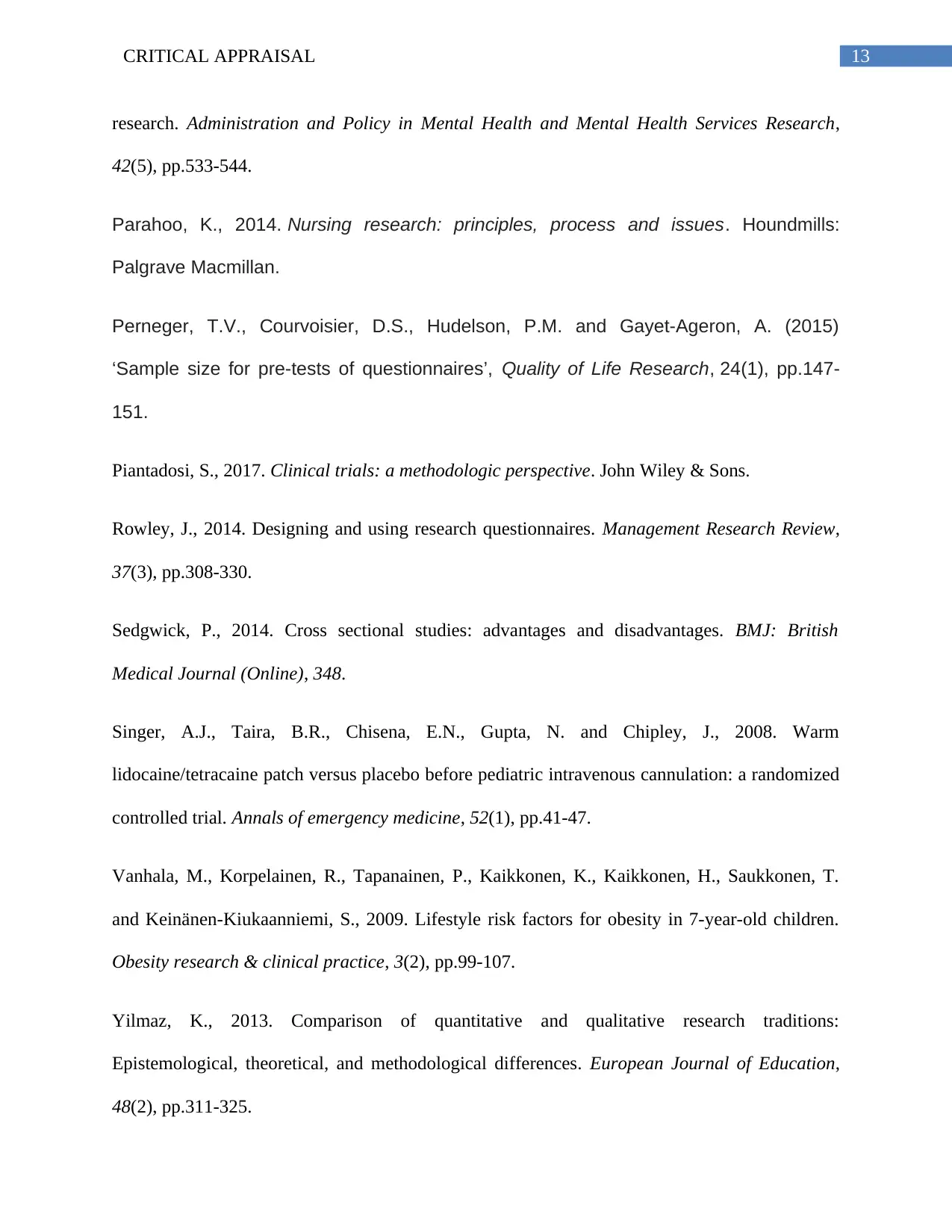
13CRITICAL APPRAISAL
research. Administration and Policy in Mental Health and Mental Health Services Research,
42(5), pp.533-544.
Parahoo, K., 2014. Nursing research: principles, process and issues. Houndmills:
Palgrave Macmillan.
Perneger, T.V., Courvoisier, D.S., Hudelson, P.M. and Gayet-Ageron, A. (2015)
‘Sample size for pre-tests of questionnaires’, Quality of Life Research, 24(1), pp.147-
151.
Piantadosi, S., 2017. Clinical trials: a methodologic perspective. John Wiley & Sons.
Rowley, J., 2014. Designing and using research questionnaires. Management Research Review,
37(3), pp.308-330.
Sedgwick, P., 2014. Cross sectional studies: advantages and disadvantages. BMJ: British
Medical Journal (Online), 348.
Singer, A.J., Taira, B.R., Chisena, E.N., Gupta, N. and Chipley, J., 2008. Warm
lidocaine/tetracaine patch versus placebo before pediatric intravenous cannulation: a randomized
controlled trial. Annals of emergency medicine, 52(1), pp.41-47.
Vanhala, M., Korpelainen, R., Tapanainen, P., Kaikkonen, K., Kaikkonen, H., Saukkonen, T.
and Keinänen-Kiukaanniemi, S., 2009. Lifestyle risk factors for obesity in 7-year-old children.
Obesity research & clinical practice, 3(2), pp.99-107.
Yilmaz, K., 2013. Comparison of quantitative and qualitative research traditions:
Epistemological, theoretical, and methodological differences. European Journal of Education,
48(2), pp.311-325.
research. Administration and Policy in Mental Health and Mental Health Services Research,
42(5), pp.533-544.
Parahoo, K., 2014. Nursing research: principles, process and issues. Houndmills:
Palgrave Macmillan.
Perneger, T.V., Courvoisier, D.S., Hudelson, P.M. and Gayet-Ageron, A. (2015)
‘Sample size for pre-tests of questionnaires’, Quality of Life Research, 24(1), pp.147-
151.
Piantadosi, S., 2017. Clinical trials: a methodologic perspective. John Wiley & Sons.
Rowley, J., 2014. Designing and using research questionnaires. Management Research Review,
37(3), pp.308-330.
Sedgwick, P., 2014. Cross sectional studies: advantages and disadvantages. BMJ: British
Medical Journal (Online), 348.
Singer, A.J., Taira, B.R., Chisena, E.N., Gupta, N. and Chipley, J., 2008. Warm
lidocaine/tetracaine patch versus placebo before pediatric intravenous cannulation: a randomized
controlled trial. Annals of emergency medicine, 52(1), pp.41-47.
Vanhala, M., Korpelainen, R., Tapanainen, P., Kaikkonen, K., Kaikkonen, H., Saukkonen, T.
and Keinänen-Kiukaanniemi, S., 2009. Lifestyle risk factors for obesity in 7-year-old children.
Obesity research & clinical practice, 3(2), pp.99-107.
Yilmaz, K., 2013. Comparison of quantitative and qualitative research traditions:
Epistemological, theoretical, and methodological differences. European Journal of Education,
48(2), pp.311-325.

14CRITICAL APPRAISAL
1 out of 15
Related Documents
Your All-in-One AI-Powered Toolkit for Academic Success.
+13062052269
info@desklib.com
Available 24*7 on WhatsApp / Email
![[object Object]](/_next/static/media/star-bottom.7253800d.svg)
Unlock your academic potential
© 2024 | Zucol Services PVT LTD | All rights reserved.




